Internet of Things (IoT) Applications
Info: 6376 words (26 pages) Dissertation
Published: 21st Jan 2022
Tagged: Internet of Things
ABSTRACT
Give a small description about the (IoT) Internet of things converting the things around us and the things that we use in our daily lives to clever things. Even our lives become smart life. It’s an internet of things (IoT) “If you think that the internet has changed your life, think again. The IoT is about to change it all over again!”[1]
Table of Contents
Click to expand Table of Contents
1. Overview
1.1 Introduction
1.2 What is internet of things?
2. Internet of Things uses (IoT).
2.1 In homes:
2.2 In medical field.
2.3 In manufactory.
2.4 Internet of Things advantages & disadvantages.
3. Internet of Things applications (IoT)
3.1 Internet of Things devices and example:
3.2 Solutions in the market:
4. Internet of Things (IoT) components
4.1 Things:
4.1.1 Sensors
4.2 Data
4.2.1 Data storage:
4.3 Users.
4.4 Processes.
5. IOT ISSUES
5.1 Security, Privacy and Trust
5.2 Hacker Heaven
5.3 Privacy Minefield
6. Business and experience
6.1 Winners and losers
7. Internet of Things in the market (IoT)
8. Practical experiment
9. References
Table of Figures
Figure 1(Ecobee smart Wi-Fi thermostat)
Figure 2(Spot security camera)
Figure 3(Philips Hue smart lighting)
Figure 4 (Products electronic board)
Figure 5 (IoT components)
Figure 6(centralized data)
Figure 7(Distributed data)
Figure 8 (password interface)
Figure 9 (Terminal window)
Figure 10 (Cooja startup)
Figure 11 (The blue empty window)
Figure 12 (New simulation window)
Figure 13 (Info about simulation)
Figure 14 (add new mote)
Figure 15 (description for your simulation)
Figure 16 (description of the simulate)
Figure 17 (choose the number of mote you need)
Figure 18 (the type of mote)
Figure 19 (choose the number of mote to work as a switch)
1. Overview
1.1 Introduction
In the 80s and 90s from the last century the world lived in age of personal computing and this computing extended to around 20 years. The internet of things term was named in that name in 1999 by Kevin Ashton, and he was the first person who used internet of things term.
Internet in the beginning were used for specific people who are work in companies or banks, not any one can use the internet because it will cost him a lot of money.
Since then the internet evolution every year and take a big step forward until it became a revolution in the communication. Also with the evolution of experts and screens roaming mobility moved to an age where the form of the emergence of the phone in Early 2007 launch of the new time of technology and the new age of computing. From that time until now days almost everyone has a smart phone in his pocket that can do whatever the computer were do, and no one can believe that in the future will have something do what the computer do but with smaller than the computer.
The internet of things (IoT) is a big network with different devices such as computers, smartphones, car systems or even elevator systems and other different systems in our daily lives. All these systems are integrated together easily through internet network so they can exchange information’s between each other. The internet of things (IoT) is became a revolutionary in the concept of the internet and communications, because all the machines that connected to the internet is the source of the data instead of the human doing it.
When Kevin Ashton use the Internet of Things (IoT) term, the main idea was to connect some of the devices in our lives in a way that allows us to know the conditions of all these devices and the accurate information without need to be next to these devices, the big companies liked this idea like Gartner company who are interested in this field and has some research about it.
Now days the Internet of Things is one of the must an invention in technology and electrics, and its start spreads in big way in the big countries like Japan, US, China. And it has reaches in the latest statistics from garth Inc. says “forecasts that 6.4 billion connected device will be used on all over the world in 2016, up 30 percent from 2015, and will reach 20 billion be 2020. In 2016 5 million new things will get connected every day”. These numbers tell us that how fast the development of technology is and how it will be in the future, it will be in everywhere. (“Gartner Says 6.4 Billion Connected ‘Things’ Will Be in Use in 2016, Up 30 Percent From 2015,” n.d.)
In 2020 they expected for the internet of things (IoT) market will be two times bigger than smartphones and computers and tablets market together. Also they expect the number of users that they use Internet of Things (IoT) in 2020 will reach to 35 billion device connected to the internet, because of that they now works on IPv6 to absorbs the number of users in the future because the IPv4 now is running out of IPs. In addition they expect the income of Internet of Things (IoT) market will be more than 600 billion$ in 2020.
Who will manage or control Internet of Things (IoT)?
There is no company will control it, but there are companies will be the big part on this project and those companies are:
- Cisco: the Internet of Things (IoT) is a group of devices connected together through a network, and when we say network cisco has the big part on it; it has important research on this field.
- Microsoft: Microsoft will run a special version of windows for Internet of Things (IoT) that qualifies them to lead the software in Internet of Things (IoT).
- Google: with her experience with consumer and big data and business intelligence (BI), in addition it’s on the top of the age of smartphone we live now, Google has all the things that needed to make an intelligent solutions to make the user has the full benefits of Internet of Things (IoT).
- Intel: the number of the devices that will be in Internet of Things (IoT) in 5 years will be two times the number of smartphones, computers, tablets together in our lives now, and who’s better than inter to make that number of the hardware with good quality.
1.2 What is internet of things?
IoT is a thing or object in the IoT is described as any item from our daily life that is enhanced with some computing and/or communication capabilities. For instant items or objects with sensor technologies will become connected object. These objects depending on the application might rang from a size as small as an atom or as large as building, they might be fixed or mobile, such as a car that might be inanimate or animate, such as animals or humans.
These objects joining an IoT service will have an electronic identification such as RFID. Object or things are also new electronic devices interaction with environment such as sensors. (Chaouchi, 2013)
The Internet of Things (IoT) is anything could be like clothes, furniture, and part of the human body, streets or even the animals. In simple way anything could has CPU and internet connection could be a thing of Internet of Things (IoT). For example: some farms over the world started to insert chips in the cows so they can monitor the healthy status of all the animals so they can know the best time to feed them or to take the milk and that help the owners of the farms to improves the production process.
Internet of Things is a growth concept for the Internet so that possesses all of the things in our lives viability of connections to the Internet or to each other, whether wired or wireless communication in order to send and receive data to perform specific functions through the network, Public idea the Internet of Things refers to the networking interconnection of everyday themes or objects, like social media, summary means the internet of things the connect of physical or any things to the Internet and you can access remote and controlling. All that is provide with identifiers like IP or applications and the ability to transfer data over a network without requiring to human.
2. Internet of Things uses (IoT)
2.1 In homes
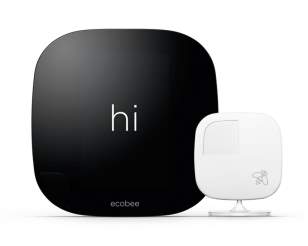
In the future of the Internet of Things (IoT) the expected the entire thing in the house such as bedrooms, living room, kitchen, bathroom, garage…etc., will turn to smart part and you can control the glow of lights or turn it on or off, also you will be able to control the air condition like when you come back to your home after work, you can turn the air condition on and set the temperature. In Internet of Things (IoT) you will connect your home together and everything complete some of it. The smart house means a comfortable and secure life because you will be able to monitor your house from any place on the world. In addition you can set alarm to anything in your house for example refrigerator and it will send notifications to your smartphone to let you know that something will finished and you need to buy more stuff. (“The Internet of Things – An Interactive Primer — Information is Beautiful,” n.d.)
Ecobee smarter Wi-Fi thermostat
This device will let you monitor home lifestyle owners and what they like or don’t like such as wake up time or playing favorite songs when the inter their home and even they will be able to set the temperature in specific time. Having this device means the ability of the house owners to control the rate of consumption of energy without making any effort. (Figure 1)(“Smart WiFi Thermostats by ecobee |,” n.d.)
Figure 1(Ecobee smart Wi-Fi thermostat)
Spot camera
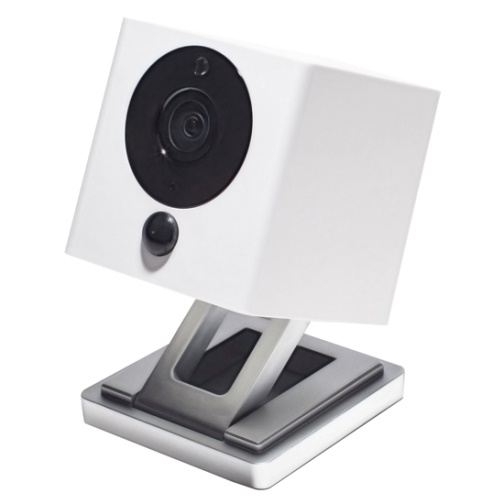
The only home camera that understand smoke alarm and can give brief a day in second with Time Lapse. Spot is a smart home camera and much more than that, it’s easy to use and has a lot of capabilities. Spot is your watchdog, your ears, intercom; you’re link to your home. Spot has all of futures and option you need like night vision, HD resolution streaming video, motion and audio detection, zoom, local and cloud video storage and 2 ways audio. (Figure 2)(“iSmartAlarm – Spot,” n.d.)
Figure 2(Spot security camera)
Philips Hue smart lighting
Philips smart lighting is a home smart lighting, the idea from this smart lighting is to provide the lighting in different way and you can control it through the smartphone via an application and it has hundreds of colures. In addition to reducing energy consumption. (Figure 3)(“Philips Hue | Meet Hue,” n.d.)
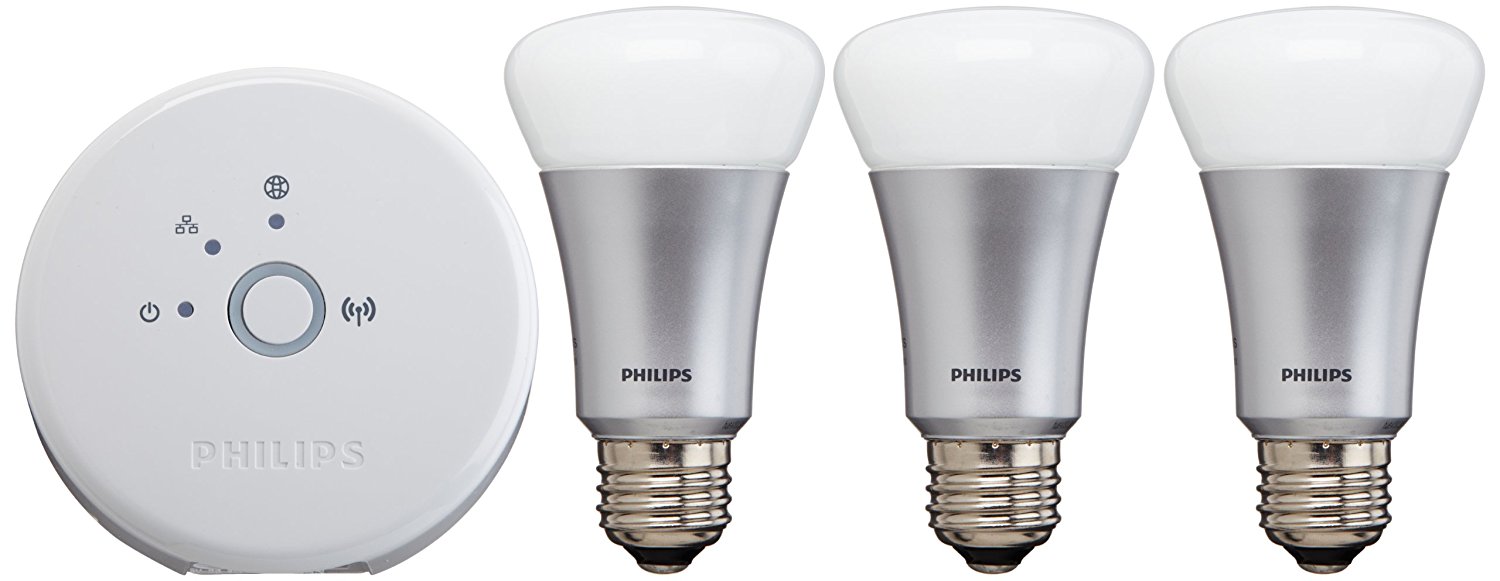
Figure 3 (Philips Hue smart lighting)
2.2 In medical field
The technical is has been goes in a lot of developments in all field, in the medical field you can create a huge database for all the patients. It allows the doctor’s to see the medical history for the patients and what pharmaceuticals he take, also monitoring the patients files. In the technical developments in the medical equipment’s it allows the doctors to monitor the patients via the internet such as monitoring the heartbeat, breathing. The development of medical field started by adding sensors on the patients to monitor specific things in his body.
2.3 In manufactory
Using Internet if Things (IoT) in manufactory we can do the processes remotely, also it can gives the supervisor alerts if any machine need prepare or fixing something in it. In addition we can monitor the gaseous emissions of toxic and avoid it for not effect on the environment or the society.
2.4 Internet of Things advantages & disadvantages
There are many advantages and disadvantages of using Internet of Things (IoT) in our lives we will go through some of them (“Pros & Cons of Internet Of Things (IOT) | Bhaskara Reddy Sannapureddy | Pulse | LinkedIn,” n.d.)
Advantages:
Monitor
You will be able to watch your home via smartphone and you can know what your refrigerator need without open it, it will send notification to your smartphone, and in smart camera you can see who came to your home and what he is doing.
Time
Internet of Things (IoT) will save time because no need to goes to every lamp and device to turn it off, just one click and your good to go. Also if you went out from home and you forgot to close the air conditions or the heater, you will be able to turn it off even when you out your home.
Save money
You can control and utilization of the energy resource can save by insert this technology and keep the devices under control. And it alarms you if anything goes wrong.
Better life quality
All the application for this technology will make the home owners feel comfortable and better management and improve the life quality.
Disadvantages:
Safety
Let’s say if there are some hackers will hack your home or any device in your home, he will be able to control everything in your home and you will be in trouble for losing that control, or if you want to buy stuff for cooking and the store bring something expired.
Compatibility
When you buy smart devices manufacturers will make an application for that device to control it, and if you buy more devices that mean more applications, for that it might all the companies and manufacturers will have a one standard to work on it like what we see in network protocols. But compatibility for some devices leading to some problems with users and makes them monopoly the market.
Technology leading lives
Technology will control almost everything in our lives and we will addict for it. For that we have to control it before control us and make our live easier and enjoyable and not making the technology effect on the relationships or the community.
3. Internet of Things applications (IoT)
There are so many types of Internet of Things (IoT) in different categories, the popular one is (smart watch, smart homes, smart manufacturing, smart building, transport, education,…etc.) the new generation of the watches now is the smart watches and the demand is increasing every year all over the world and a lot of big companies has been invested In this technology and they have a good incoming from it.
The smart homes, is important application for many reasons: security, quality of life, comfort, and now days we actually use some devices in our homes related to IoT like lamps, TVs, cameras, air conditions all of these thing will improve the revolutions of the smart homes and make a new age of technology and comfort. The smart manufacturing also will bring a revolutions in the manufacturing instead of the old ones, because it makes the works and the employees easier and comfortable and the quality of products is increasing, in addition the factory owners will but sensors in the machines to monitor it and send alerts for the supervisor to inform him that something is about to happened in the machine or some of the components is about to finished and that will make him know the thing before it happened and that will save his time and keep the factory work all the time.
In smart transport, Internet of Things (IoT) will help the police to track any car or to monitor the traffic and see what happen on the streets so they can make decision for it. The Internet of Things (IoT) in educations will help the student to learn more and learn with fun and make the learning process easier and helpful, also the students can share their works between each other or what we see in TTC exams, the teacher share a file with the students then the students open that file and take the test, in addition the students can expand their knowledge in one click not like the old days you have to search in books and libraries.
Farmers are using meaningful insights from the data to yield better return on investment. Sensing for soil moisture and nutrients, controlling water usage for plant growth and determining custom fertilizer are some simple uses of IoT, such as Green Houses.
3.1 Internet of Things devices and example
- Amazon echo for smart home: Amazon echo work through the voice and it call herself Alexa, it allows the user to talk to her for doing some functions for them such as playing music, tell them about the weather report for the day, and can get information’s about soccer and more than that.
- Fitbit one for wearable: Fitbit one can track your steps and how many floors you climbed, also how many calories you have burned and how was your sleep, this device is syncs with the smart phone or computers and you can see the daily report for you and copy your data to anywhere and gives you a daily chart for your exercise.
- AT&T for connected cars: AT&T added around 1.3 million cars for the network in the middle of 2016 that number brings them to the total number of connected cars to 9 million. The users don’t have to pay any money for AT&T for this service.
3.2 Solutions in the market
One of the most reasons to invent Internet of Things (IoT) in the world is to save time and do thing without being around it. For example, in South Korea, the second famous supermarkets there (see Figure 5) want to be the number one with cost saving and without opening any new branches, so they make a case study to see how the Koreans act and what they interested to. They found the Korean is fast (he doesn’t like to waste his time) also they found the Korean society use the underground subways in all his movements, so they came with an idea to increase sales depending on the reports and save time on waiting the metro to do supermarkets shopping while they waiting the metro.
They hang up on electric boards with products pictures, so when he want to buy something all he has to do is to open the supermarket app and scan the barcode on the plate to add it to the chart (see Figure 4), when he finish buying all what he need the next step is to pay by the credit card and choose the time and the date to deliver his goods to the address he chosen, if some products that you want finished from the market he will tell you immediately that products is finished. After you take you stuff you sign on a paper that you received it. Also in Dubai the have the same idea but the developed it to includes more than a supermarket.
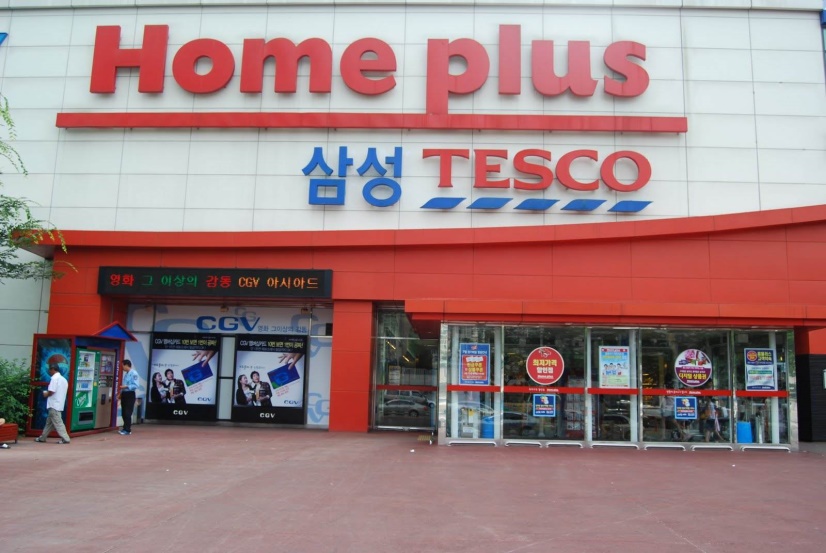
Figure 4 (Home Plus supermarket)
More info watch (khawater S08 episode 20)(“خواطر 8 – الحلقة 20 – كوريا مكس – YouTube,” n.d.)
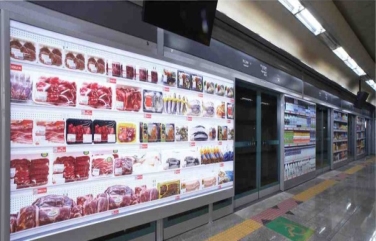
Figure 4 (Products electronic board)
4. Internet of Things (IoT) components
In the internet of thing we have 4 main components, these components are: Things, sensors, data, users
Here are more details about each component: (Figure 6) (“نتائج البحث عن ‘انترنت الاشياء-15’ – مدونة مصطفى صادق العلمية,” n.d.)
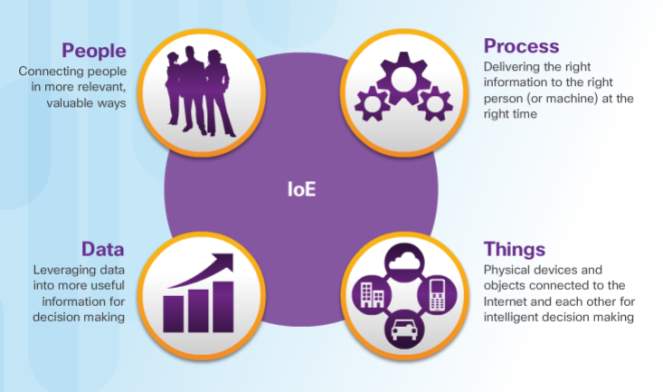
Figure 5 (IoT components)
4.1 Things
Internet of things will to join all types of devices including these devices which is not connected to the interne yet, for that, cisco expect that 99% of thing around us will be connect it internet. Those thins conclude deep technics to interact with the inside server and the environment, and of course all these things connect something that make them to communicate with the other components in the network and it should has network-capable, that’s mean it should be able to send the data through secure and trusted network. Those things that will be connected to the network will generate a huge size of data and that is one reason to come up with something called (big data or extreme data) this will change the data as soon as it have it the stakeholders when and how it will take the right decision depending on the data, all these process will happened automatically be machines and no need for the people to be there.
All the devices you want to use you must have to connect it to internet and like always there are many ways to connect it either through cables or wireless, but the cables will cost a lot of money and exhausted for that almost every device and things will connected wireless and there are many technics to connect such as (Wi-Fi, NFC, Bluetooth, cellular….etc.). Some devices it might use many technics to communicate depending or the place in the network and the battery life.
4.1.1 Sensors
One of the important devises and will be the backbone of Internet of Things (IoT) is the sensors and RFID and the controller that connect it to internet. In 2012 the number of things connected to the internet is exceeded the number of humans and it has a lot of the regular computing devices and cells as well as the new things they started to be in all fields of industry such as all kind of sensors. This number seems to be big but it’s nothing comparing to what planned to be connected in future. The sensors are a way to collects information from non-computing devices because it convert the physical phenomena in our environments to electrical signals that computer understand. For example: soil moisture sensor, radiation sensor and air temperature, all these sensors and the other ones will have a big part in the future of Internet of Things (IoT).
4.2 Data
The data is the value from any thing around is in everywhere, the data itself it doesn’t mean anything, but with the comparative and analyses it could be helpful and useful. In the electronic communications the data is the 0s and 1s we call it (binary digit) and all the electronics are save the data in this form because the computing doesn’t understand anything else. The benefits of using this form because it easy to save and restore in all types of storage without losing information’s.
4.2.1 Data storage
As we all know that data storage is increasing every while and there are three types of data storage:
- Local data: we mean here the data that we can get easily stored in hard drive of USB flash drive or CD.
- Centralized data: the type of storage that you can store all the data in a centralized server with the ability for access remotely to it through all the devices in the network, and that type has a problem, that problem is the failure in the network because it will form something called (bottleneck) which is all the access request come to the server in very short time and the server will work slow because it can’t accept all request in one time.(see Figure 7)

Figure 6 (centralized data)
- Distributed data: is the data the can manage it through a distributed data base management system (DDBMS) which store more than one copy of the data in many places, that allows easily to share the information’s because it allows the local and remotely access and that doesn’t make the system goes down because there more than one server it could send the information’s you need for the multi-users. (See Figure 8)
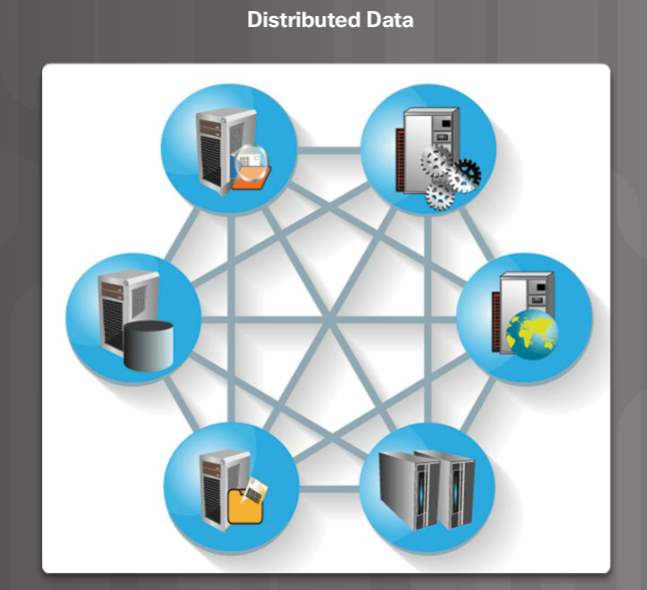
Figure 7(Distributed data)
4.3 Users
The data itself has no value without converting it to information can user use it to improve his decision. For that the users they are the center in the Internet of Things (IoT) and they are the producers and consumers to all the data exchange and transmitted to Internet of Things (IoT), for that we can separate the communication into 3 types:
- People to people connection (P2P)
- Machine to people connection (M2P)
- Machine to machine connection (M2M)
One of the main goals of Internet of Things (IoT) is allows to transmit the information in the right time and accurately to the users to resulting in it changing life style in a good way. As well as the Internet of Things (IoT) has something called feedback loop, that mean the ability to collect the users opinions and send it back to the system to change the service in the future depending on the users opinions and what they need the most.
As we all knows not all the people need all the things, for that provide accurate information for the producers about what the products that users look for it in the internet and what they like to use , using it will make it targeted those users more than others with what they looking for in the internet and increasing the possibility to buying it that allows the users and producers to inventing feedback loop that internet providing it Internet of Things (IoT) and support (Micromarketing) and that is what you see every day while you browsing internet, and sometimes you receive an email from a website already you bought something from them or just browsing it, you will find in the email tells you that they have a sales on something you were looking for it or some time while you browsing internet you will find some massage box for something you were looking for it before couple of days. All these things are not coincidence it just one of the applications for Internet of Things (IoT) and supporting the micromarketing.
4.4 Processes
The processes has a big part in how the other components (Things, Data, users) works together and how it will be delivering the information to the world that connected to the Internet of Things (IoT).
The processes make the connection between the users and the electronic devices and thing easier.
Machine to machine connection when the transmit happen between machine or thing to another through the internet, that connection is important and sensitive in Internet of Things (IoT). For example the connection between the car and home to let him know when the driver will arrive at home so it can turn the air condition and light as the owner want before he arrive.
The main component in machine to machine connection includes the sensors and the engines and controller. Each one of them has a connection to the network and how will this device works and how it analyses the data and pass it over to the other device.
Machine to people connection this works when data transmitted between the a device such as (computer, phone,…etc.) and the users. According to what the people like and when the want to do it. This type of connection is 2 way connection and ranges to user alarms and to the weather conditions to data analyses.
People to people connection works data transmit between one person to the other through videos or social media and that called (collaboration). The most value of Internet of Things (IoT) realized the process success to make the communications easier between all these types of connection (M2M, M2P, and P2P).
5. IOT ISSUES
The new technology always receives some challenges and fights from the hackers.
5.1 Security, Privacy and Trust
The hackers will be focus in the IOT technology, because in now days you can find the IOT in everywhere in our live, when you see most of the people have smart devices this will attract the hackers, “When you hear the word smart, here you can replace it with the word vulnerable” Mikko Hypponen, Chief Research Officer in F-Secure. Since the devices be more connected because the IOT, the security be the first thing the companies and the consumers thinking about it. The fact is security of data become the first which the companies work to upgrade it according to the 2016 Vormetric data threat report. And the biggest companies fried from the attacks on the devices and cars witch work with IOT technology such as connected cars, and smart home, because of that the biggest companies works in those days to let those devices work with more security and more privacy.
5.2 Hacker Heaven
Ways of attack: Malware, Exploitation of weak, Man in the middle (MITM), and data theft, DDOS… for example, the biggest DDOS attacks was used IOT devices as a botnet to attack servers of DYN and that attack bringing down a lot of sites. (2016)
5.3 Privacy Minefield
With the speed of separation of IOT and the big data, the privacy could be end. The scientists fear about using the information of users without knowing the customers, for example: “Samsung’s voice-recording smart TVs breach privacy law, campaigners claim” The guardian, 2015 Autocratic Control (Blackmail)
The reason for the technology it’s for help us, but maybe it will be very dangers for us if it was in the wrong hands.
6. Business and experience
There are many companies are using different standards such as:
- All seen Alliance: It has more than 51 member organizations, including Microsoft, Qualcomm and LG…
- Open Interconnect Consortium: led by Intel, Atmel, Broadcom, Dell, and Samsung.
- Thread: Formed by Google’s Nest Labs, the Thread Group includes more than 80 members
- IIOT: Founded by Intel, Cisco, AT&T, GE, and IBM
- Apple Home Kit
6.1 Winners and losers
With any new technology, there is competition and of course they will be winners and losers, we see a lot of famous technology company try to take the biggest part in the IOT which mean the IOT impotent for the big company.
7. Internet of Things in the market (IoT)
BI intelligence which is a company interested in IOT in the market and they think in 2020 there will be more than 24 billion devices of IOT in the world and this is mean they will 4 devices for each person in the world. And as the 2020 is close, the technology company will pay a lot of billions for IOT such as Applications, devices, cloud data, security, and communications, but this money which is spend for the IOT will be beneficial because in 2020 almost all the people in the world will pay IOT devices, as that money which spend will generate 13$ trillion in 2025. Who will be benefited from the IOT? There are three departments will use IOT consumers, governments, and big company. There will be many uses in IOT into groups in the three consumers, governments, and big company such as manufacturing, transportation, defense, agriculture, infrastructure, retail, logistics, banks, oil, gas, mining, insurance, connected home, food services, utilities, hospitality, healthcare, smart buildings.
8. Practical experiment
Step 1. Download Linux Ubuntu then start instant contiki because it works in virtual machine and has all development tools and simulators, after that install VMware. Then start instant contiki by VMware then wait until Linux Ubuntu boot up. After it finish booting up sign in into Ubuntu by using (user) as a password. (Figure 8)
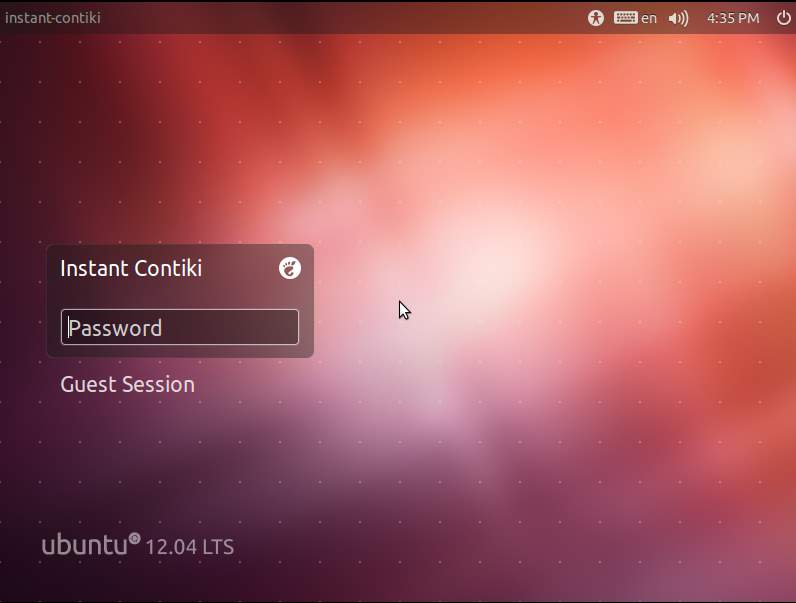
Figure 8 (password interface)
Step 2. Open a terminal window then start cooja by this command: (Figure 9)
Cd contiki/tools/cooja this step will go to cooja file by terminal window after that type ant run
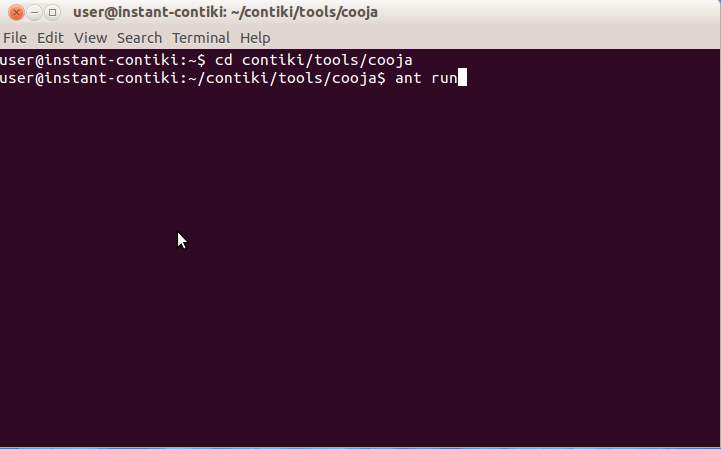
Figure 9 (Terminal window)
Wait until cooja finish start, it will take some time (Figure 10)
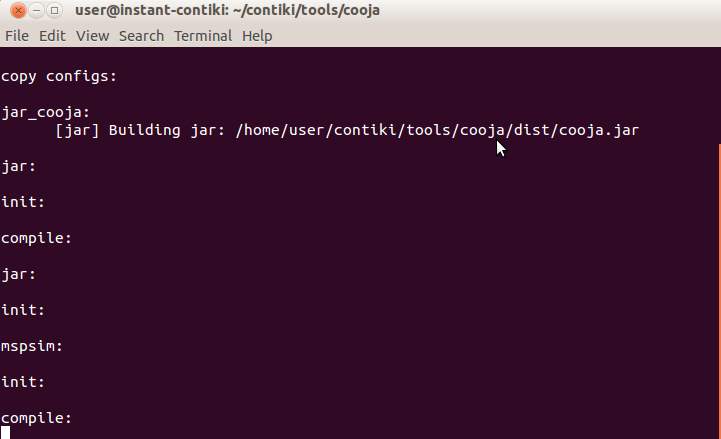
Figure 10 (Cooja startup)
After Cooja is collected it will start with a blue empty window.
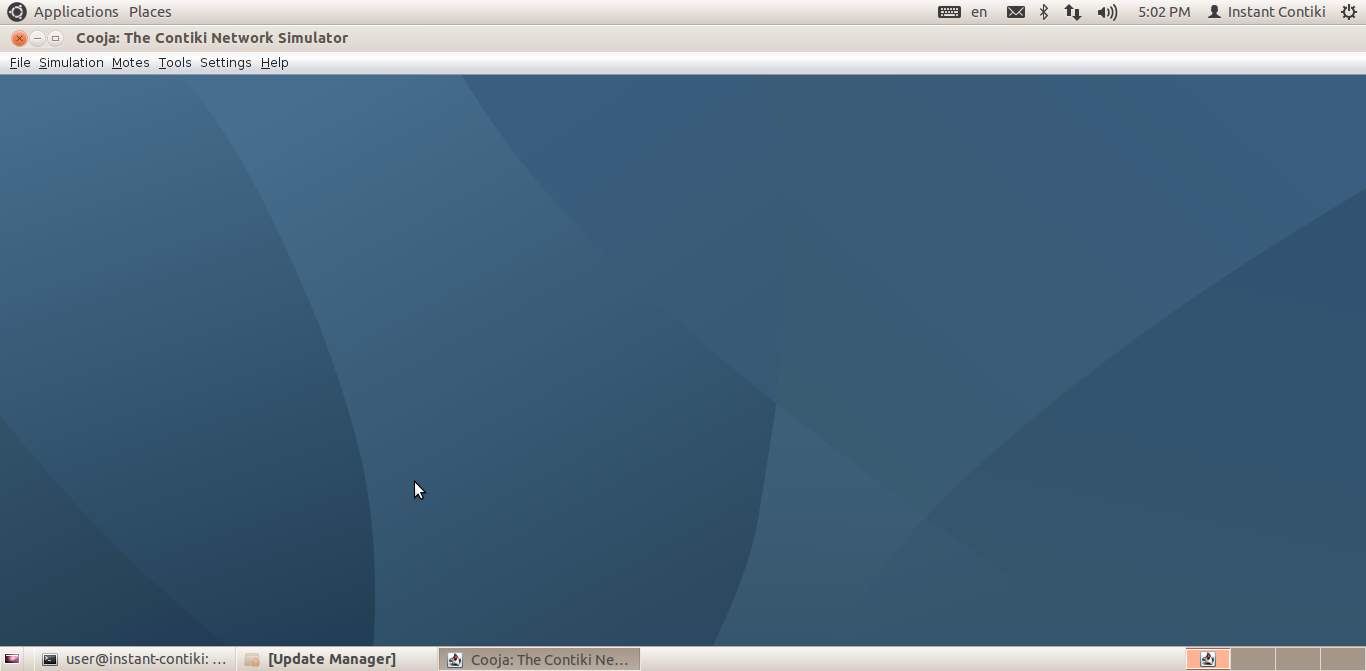
Figure 11 (The blue empty window)
When you reach this window that mean Cooja is running and ready to use. In the top of the window on the menu bar click on file then choose new simulation. (Figure 12)
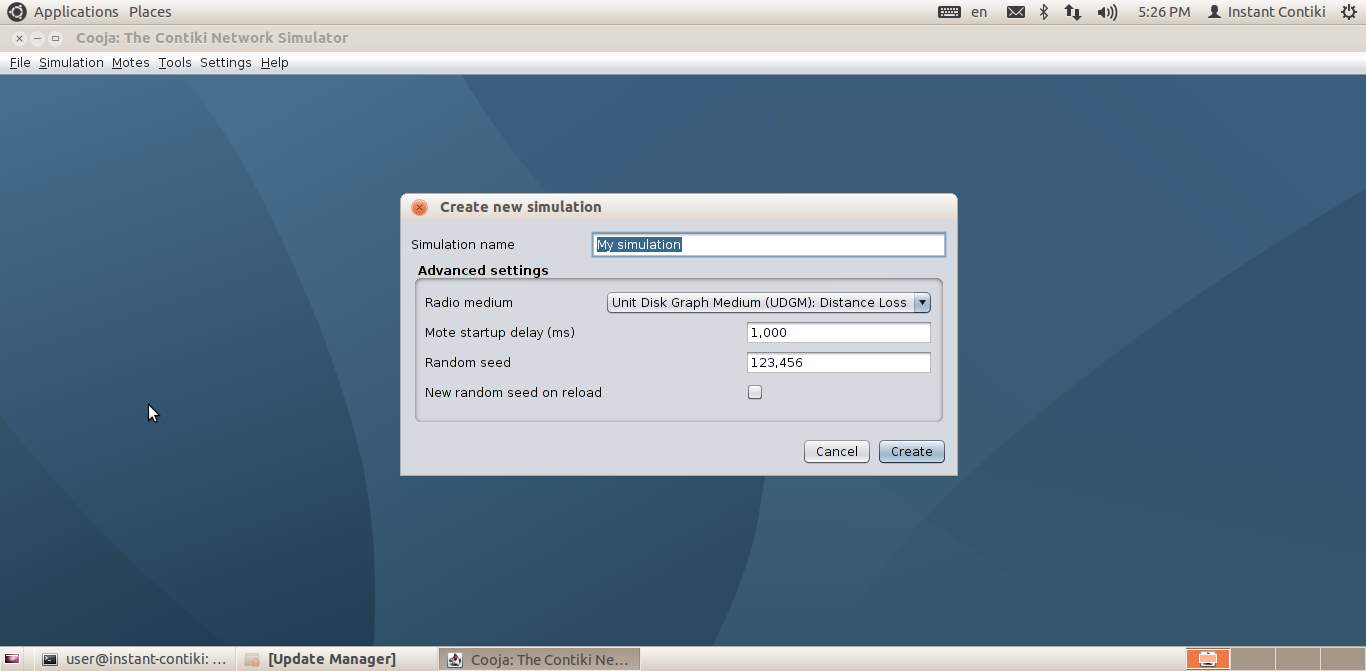
Figure 12 (New simulation window)
Cooja now will open new window, this window allows you to give your simulation a name.
The next window has many small windows; the network window is for showing all the motes you have in your network, the note window is for type any note for your simulation, the timeline in the bottom is to show all the communication events, the simulation control for to start and pause or reload your simulation, the last window is mote output, this window will show all the ports serial printout from all the motes. (Figure 13)
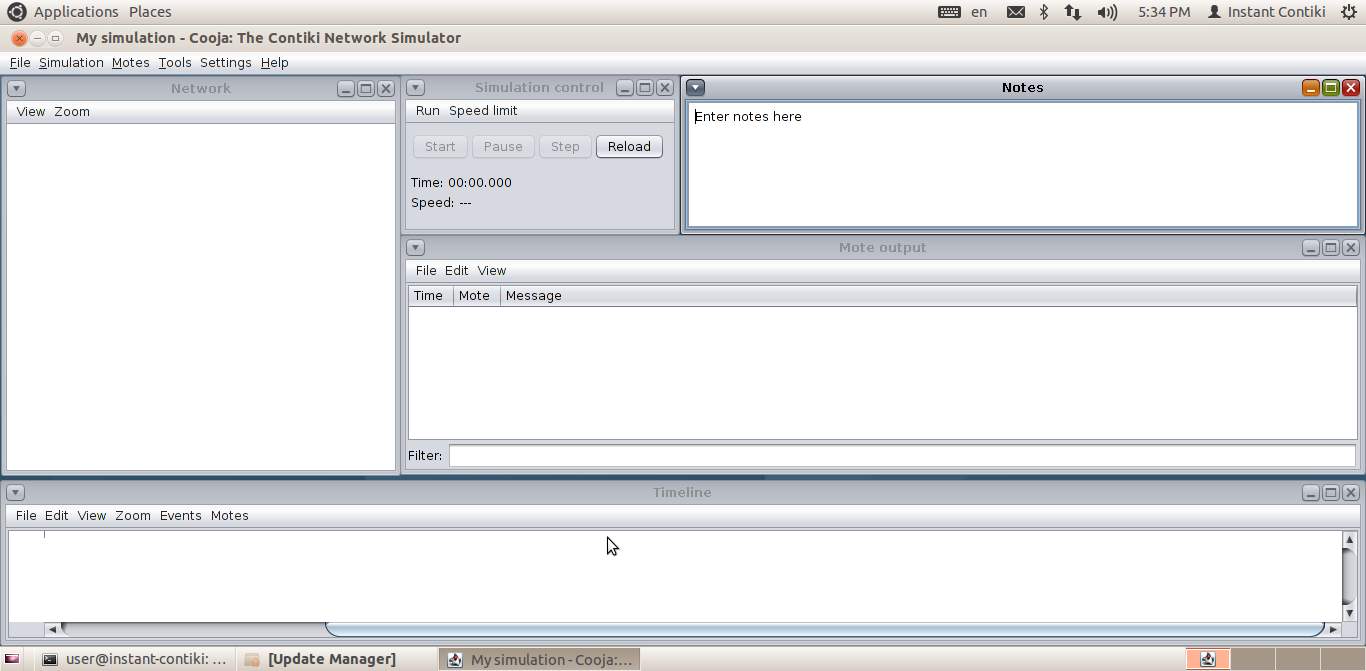
Figure 13 (Info about simulation)
From the menu bar click on motes then click on add motes after than choose the mote type then click on sky mote. (Figure 14)
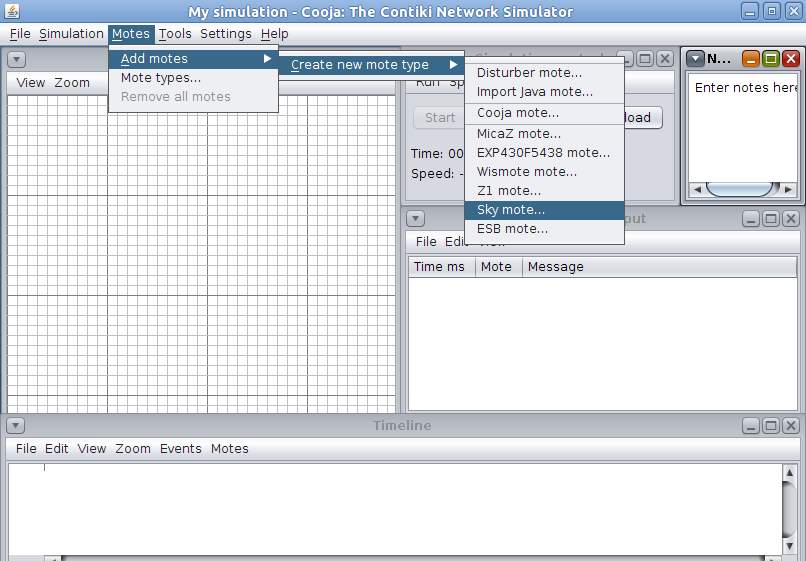
Figure 14 (add new mote)
The next window is to give a description about your simulation. After that click on brows after that go to simple-udp-rpl after that choose unicast receiver.c then click open.
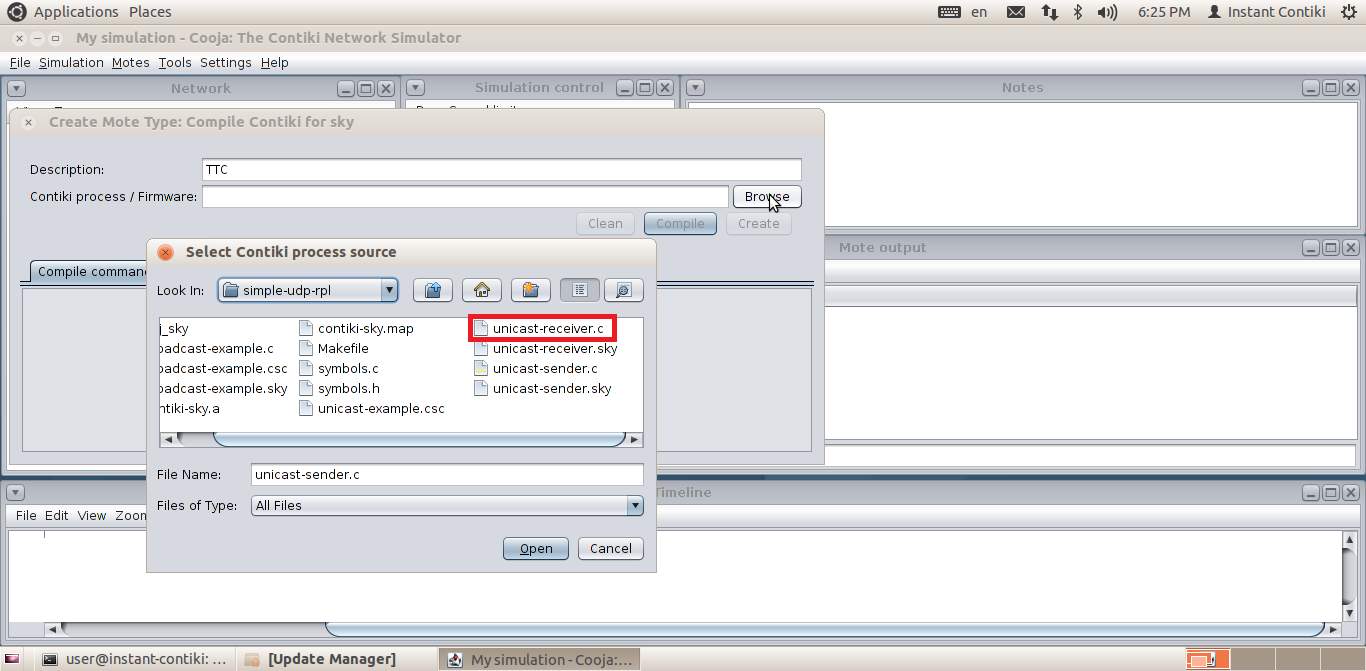
Figure 15 (description for your simulation)
The next step is to click on compile then wait until it finished then click on create, after that choose the number of mote you need to simulate as router (Figure 16 & 17)
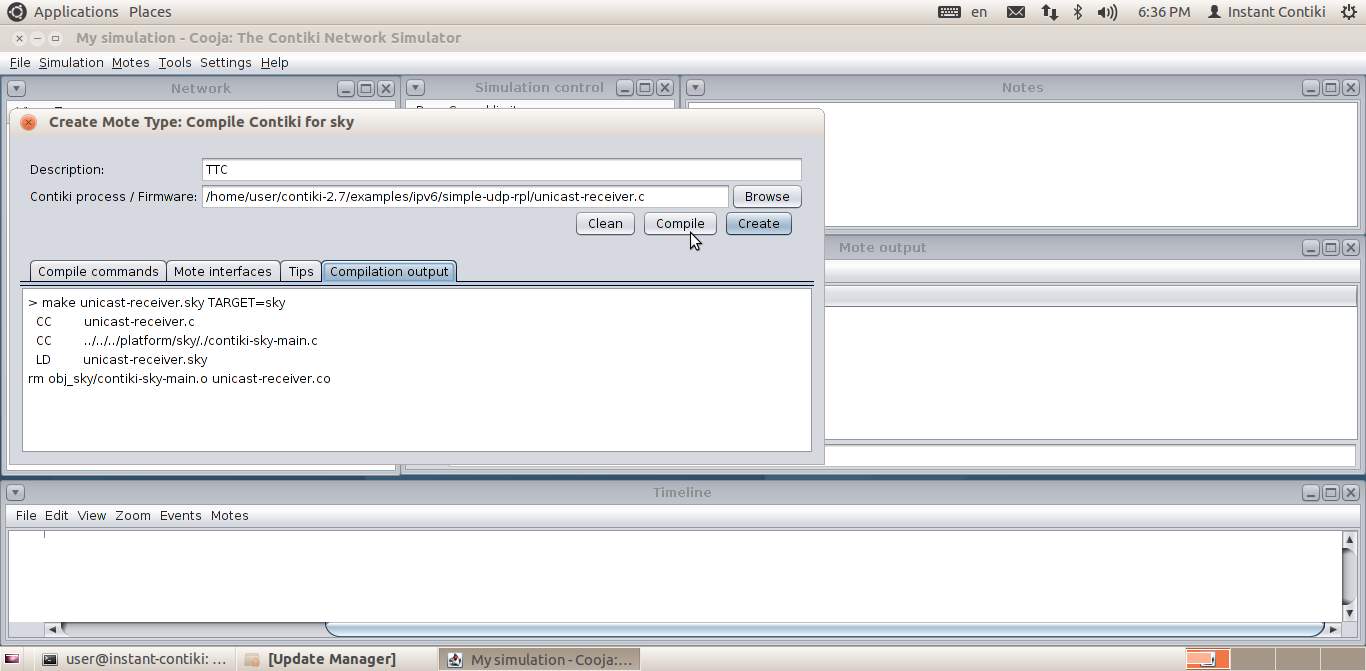
Figure 16 (description of the simulate)
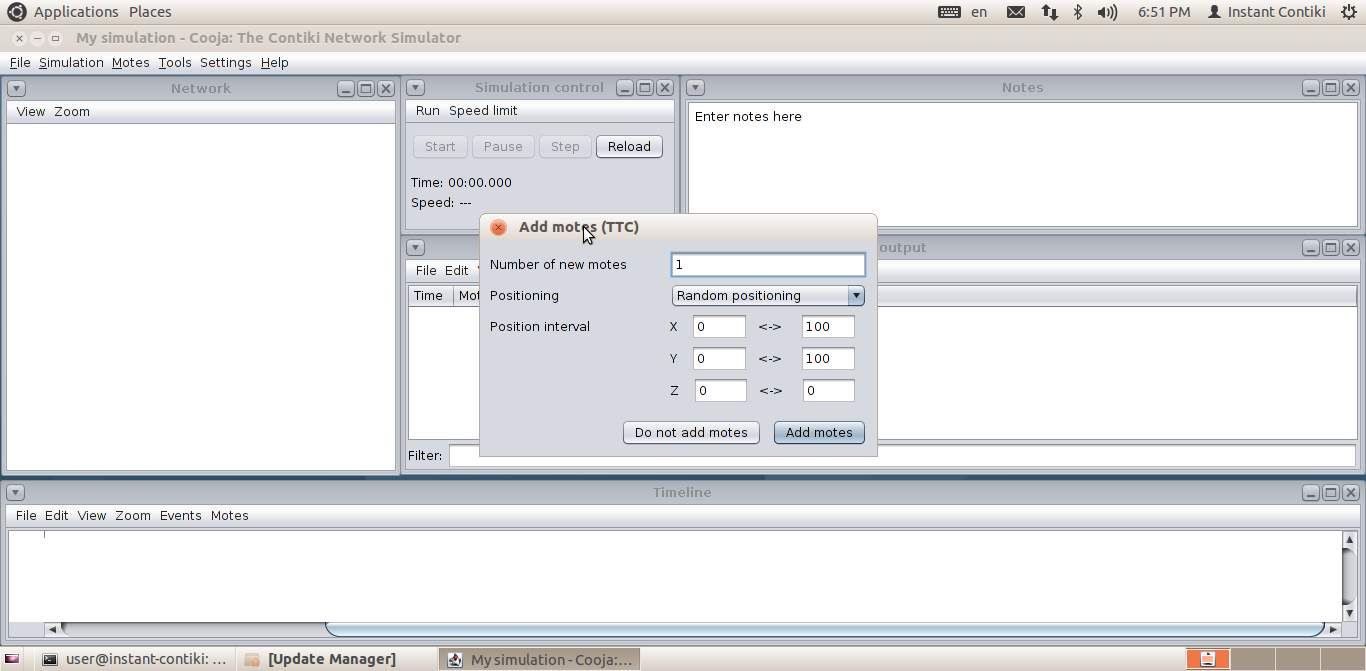
Figure 17 (choose the number of mote you need)
Repeat all the steps before but bit instead of choosing unicast receiver, choose unicast sender.c (Figure 18 & 19 & 20).
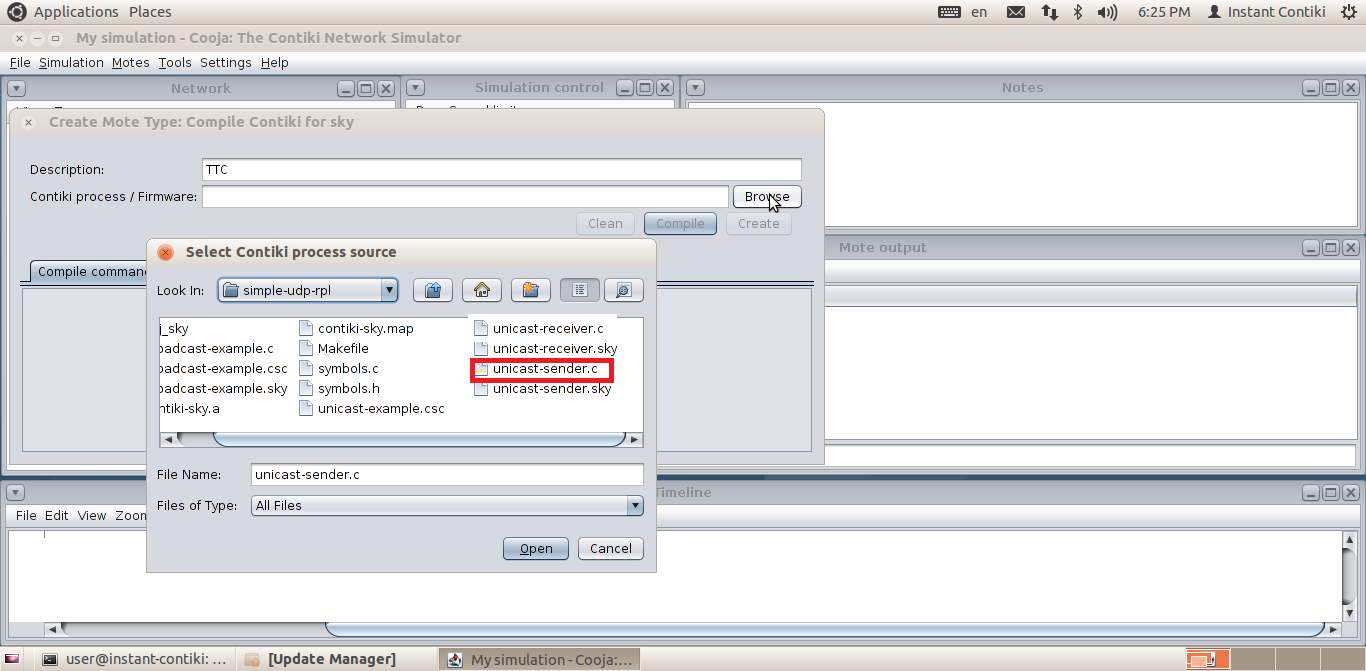
Figure 18 (the type of mote)
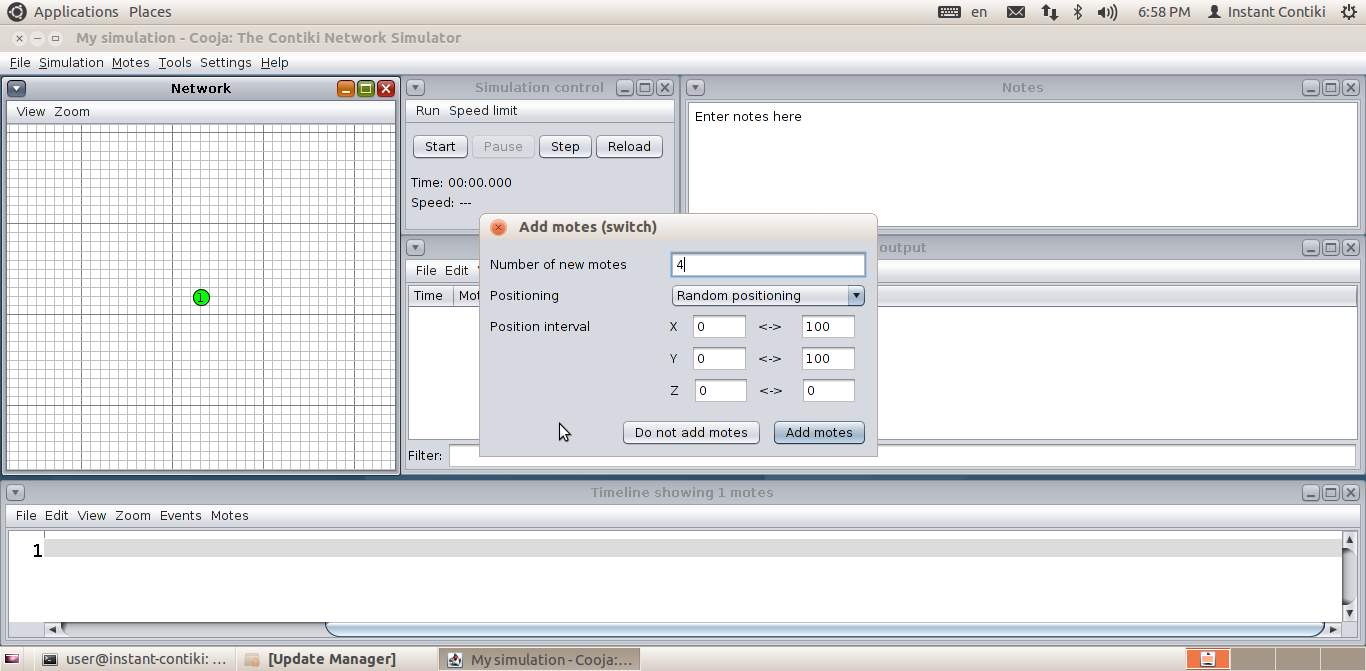
Figure 19 (choose the number of mote to work as a switch)
After all these steps the simulation is ready, click on start simulation to, now you will see in the small windows the network how it works, and the mote output and the type of the message and the IP address for each mote.
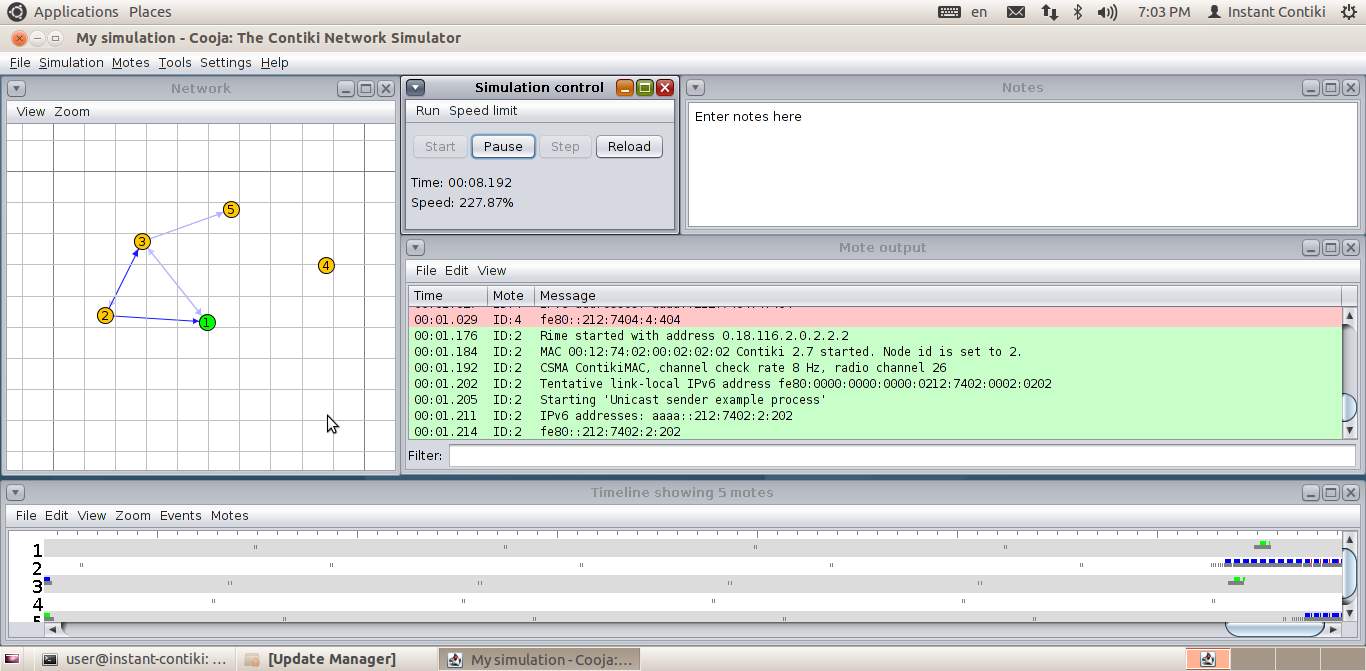
At the end if everything works very well in the simulation for a period of time, connect the hardware and start typing the commands in the terminal window.
9. References
Chaouchi, H. (2013). The Internet of Things: Connecting Objects. John Wiley & Sons.
Gartner Says 6.4 Billion Connected “Things” Will Be in Use in 2016, Up 30 Percent From 2015. (n.d.). Retrieved May 9, 2017, from http://www.gartner.com/newsroom/id/3165317
iSmartAlarm – Spot. (n.d.). Retrieved May 6, 2017, from https://www.ismartalarm.com/spot
Philips Hue | Meet Hue. (n.d.). Retrieved May 6, 2017, from http://www2.meethue.com/en-us
Pros & Cons of Internet Of Things (IOT) | Bhaskara Reddy Sannapureddy | Pulse | LinkedIn. (n.d.). Retrieved May 15, 2017, from https://www.linkedin.com/pulse/pros-cons-internet-things-iot-bhaskara-reddy-sannapureddy
Smart WiFi Thermostats by ecobee |. (n.d.). Retrieved May 6, 2017, from https://www.ecobee.com/
The Internet of Things – An Interactive Primer — Information is Beautiful. (n.d.). Retrieved May 15, 2017, from http://www.informationisbeautiful.net/visualizations/the-internet-of-things-a-primer/
Wiley: The Internet of Things: Connecting Objects – Hakima Chaouchi. (n.d.). Retrieved May 3, 2017, from http://www.wiley.com/WileyCDA/WileyTitle/productCd-1848211406.html
إنترنت الأشياء ( IoT ) : الثورة التكنولوجية التي غيرت مفهوم الإنترنت. (n.d.). Retrieved May 3, 2017, from http://palestine.paldf.net/news/2016/9/03/انترنت-الاشياء-IoT-الثورة-التكنولوجية-التي-غيرت-مفهوم-الانترنت
خواطر 8 – الحلقة 20 – كوريا مكس – YouTube. (n.d.). Retrieved May 15, 2017, from https://www.youtube.com/watch?v=iNNgiNV0GJw&t=616s
نتائج البحث عن “انترنت الاشياء-15” – مدونة مصطفى صادق العلمية. (n.d.). Retrieved May 11, 2017, from https://mustafasadiq0.wordpress.com/?s=%D8%A7%D9%86%D8%AA%D8%B1%D9%86%D8%AA+%D8%A7%D9%84%D8%A7%D8%B4%D9%8A%D8%A7%D8%A1-15
[1] Brendan O’Brien, Chief Architect & Co-Founder, Aria Systems
Cite This Work
To export a reference to this article please select a referencing stye below:
Related Services
View allRelated Content
All TagsContent relating to: "Internet of Things"
Internet of Things (IoT) is a term used to describe a network of objects connected via the internet. The objects within this network have the ability to share data with each other without the need for human input.
Related Articles
DMCA / Removal Request
If you are the original writer of this dissertation and no longer wish to have your work published on the UKDiss.com website then please:




